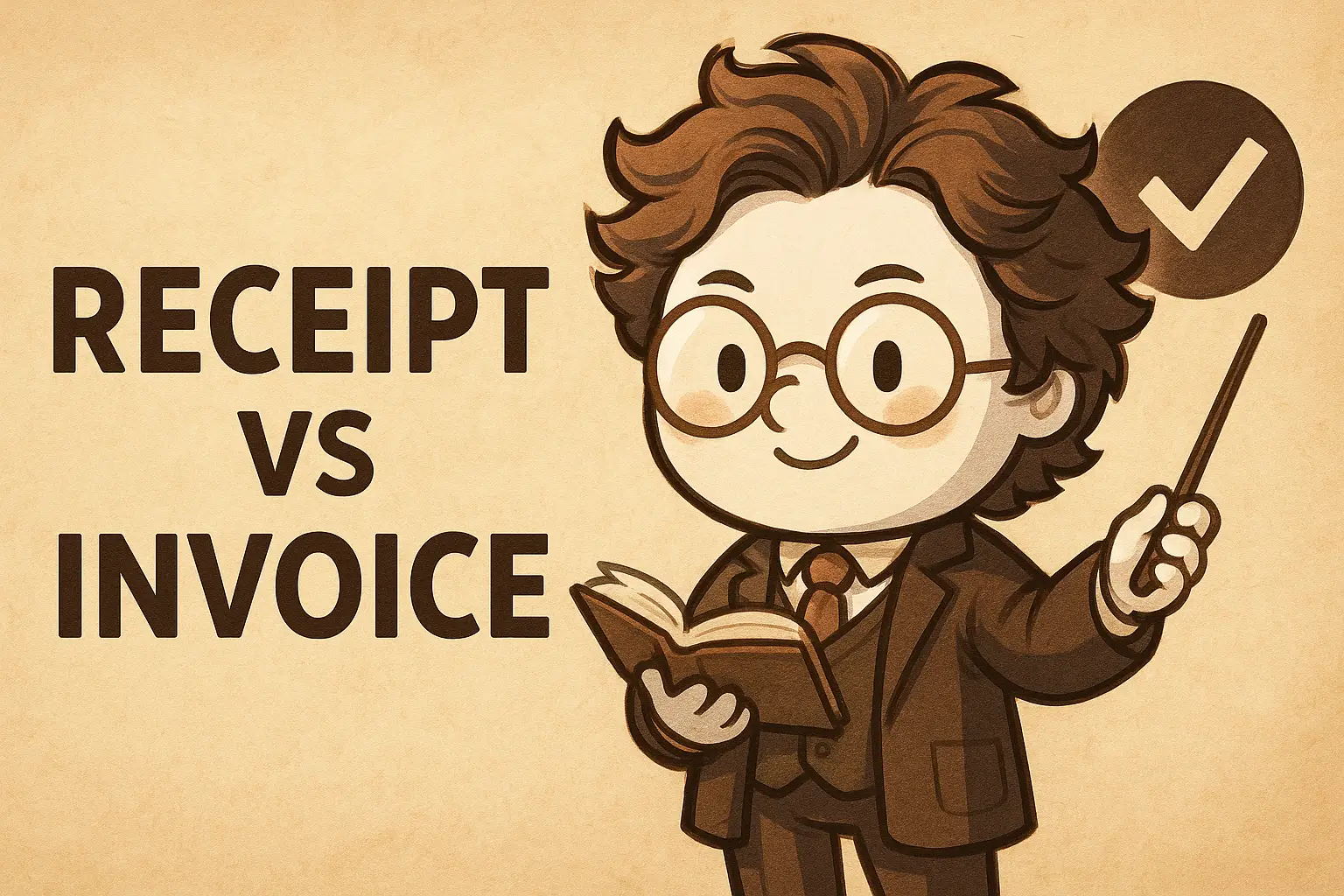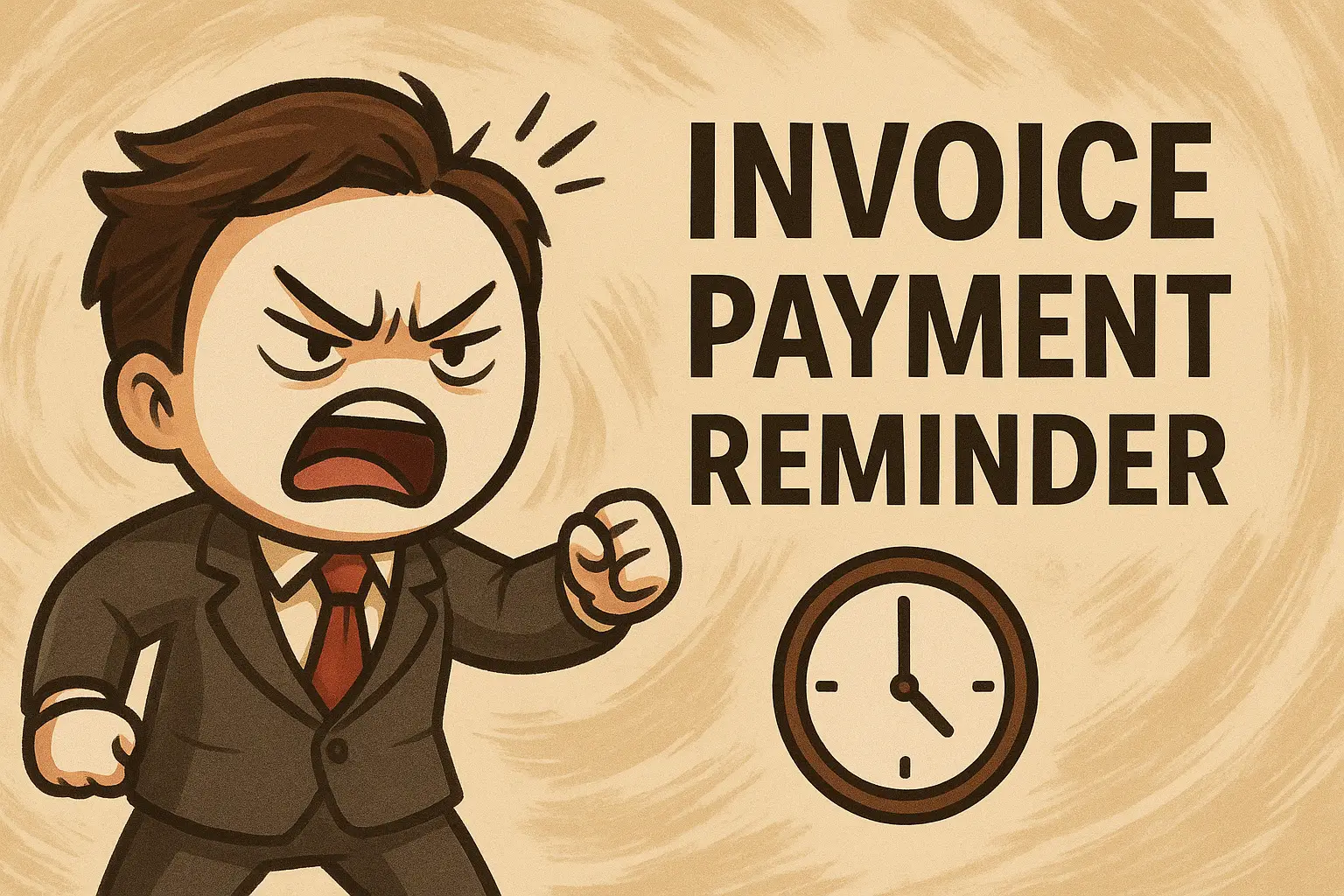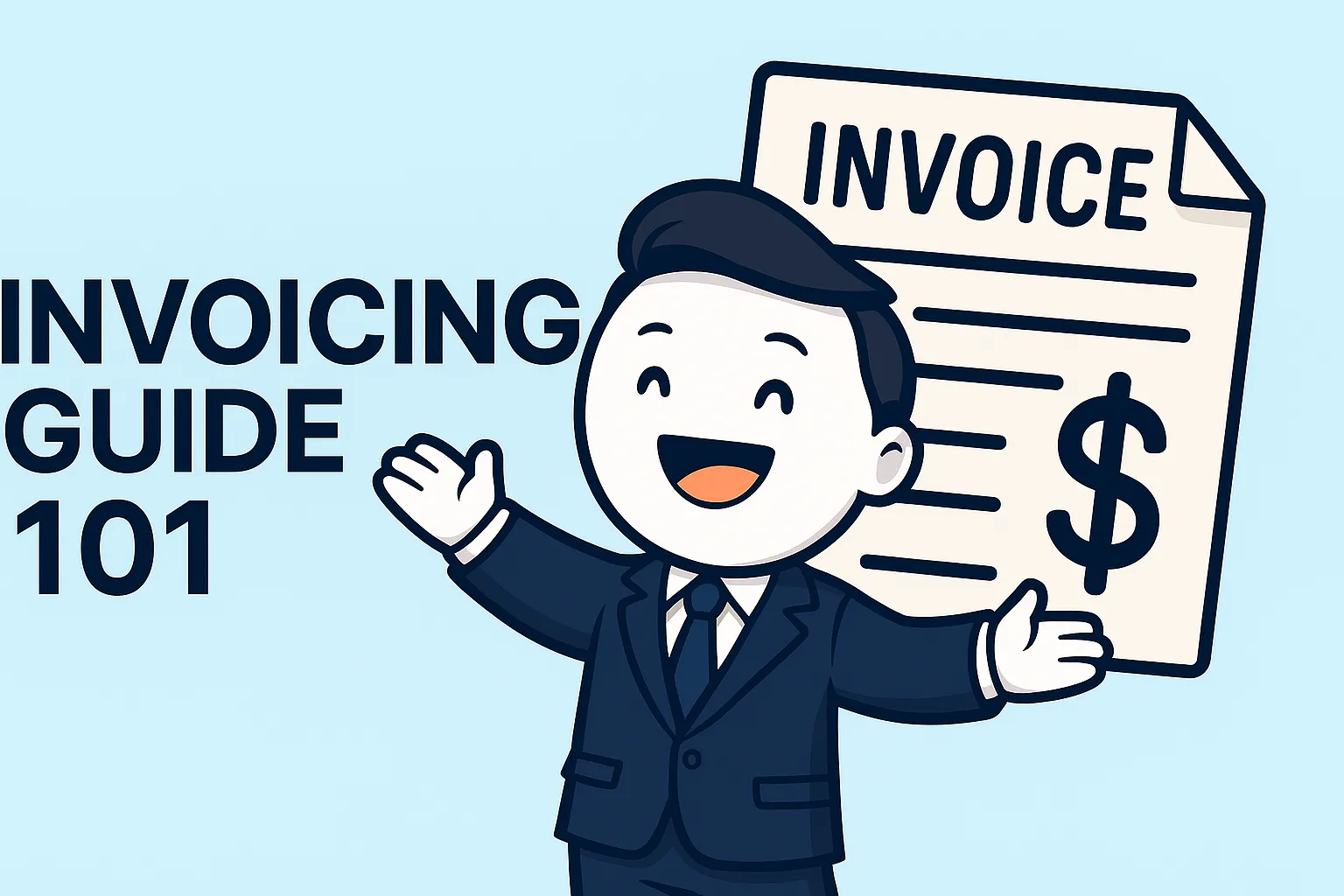If you've ever been confused about when to use an invoice versus a receipt, you're not alone. These two essential business documents are often misunderstood, yet they serve completely different purposes in the business transaction process. Understanding their differences is crucial for proper bookkeeping, tax compliance, and maintaining professional business relationships.
This comprehensive guide will clarify everything you need to know about receipts and invoices, including when to use each, what information they must contain, and how they impact your business operations and tax obligations.
The Fundamental Difference: Timing and Purpose
The main difference between an invoice and a receipt is that an invoice is a request for payment, whereas a receipt acknowledges that payment has been received. Think of it this way: invoices come before payment, receipts come after payment.
Invoices precede payment, serving as a request for it, while receipts follow payment, confirming its completion. This timing difference affects everything from cash flow management to legal compliance, making it essential to understand when and how to use each document correctly.
What is an Invoice?
An invoice is a formal payment request document that businesses send to clients or customers for goods delivered or services completed. It serves as both a bill and a legal record of the transaction, establishing the seller's right to payment.
Purpose of Invoices
Invoices serve multiple critical business functions:
Payment Request: The primary purpose is to formally request payment for work completed or products delivered. Invoices establish the amount owed and payment terms.
Legal Documentation: Invoices create a legal obligation for payment and serve as evidence of the business relationship and agreed-upon terms.
Cash Flow Management: By sending invoices promptly, businesses can manage their accounts receivable and predict incoming cash flow.
Tax Compliance: Invoices provide necessary documentation for business income reporting and tax obligations.
Professional Communication: Well-crafted invoices reinforce your brand and maintain professional relationships with clients.
When to Send an Invoice
Invoices are issued before payment in several scenarios:
After Service Completion: Send invoices immediately after completing work or delivering products to maintain momentum and encourage prompt payment.
On Set Billing Cycles: For ongoing services, establish regular billing cycles (weekly, monthly, quarterly) and send invoices consistently.
Upon Project Milestones: For large projects, invoice at predetermined milestones to improve cash flow and reduce financial risk.
Before Service Delivery: In some industries, invoices are sent before work begins, especially for custom orders or high-value services requiring deposits.
Essential Invoice Components
Professional invoices must include specific information to be legally valid and professionally effective:
Business Information: Your complete business name, address, phone number, email, and logo for brand recognition.
Client Details: Customer's full name or company name, billing address, and contact information.
Invoice Number: Unique identifier for tracking and organization purposes.
Invoice Date: The date you're requesting payment, which starts the payment term countdown.
Due Date: Clear specification of when payment is expected, removing any ambiguity about timing.
Detailed Description: Specific descriptions of all products or services provided, including quantities, rates, and line totals.
Payment Terms: Your payment conditions, accepted methods, and any penalties or discounts.
Total Amount Due: Prominently displayed total amount, including any applicable taxes or fees.
What is a Receipt?
Receipts are issued after payment as proof of the transaction. A receipt is a document that confirms payment has been received and provides a record of the completed transaction for both buyer and seller.
Purpose of Receipts
Receipts serve several important functions in business operations:
Proof of Payment: The primary purpose is to confirm that payment has been received and processed successfully.
Transaction Record: Receipts provide detailed records of completed transactions for accounting and bookkeeping purposes.
Customer Service: They give customers documentation for their records, warranty claims, and potential returns or exchanges.
Tax Documentation: Receipts support business expense deductions and provide audit trails for tax purposes.
Inventory Tracking: For product sales, receipts help track inventory movement and sales patterns.
When to Issue a Receipt
A receipt is issued after the payment has been received in various situations:
Immediate Payment: Issue receipts immediately upon receiving payment, whether cash, check, or electronic transfer.
Partial Payments: Provide receipts for partial payments or deposits, clearly indicating the remaining balance.
Final Payment: Issue final receipts when the full amount has been paid, marking the transaction as complete.
Return Processing: Create receipts for refunds or returns to document the reverse transaction.
Essential Receipt Components
Effective receipts must include specific information to serve their intended purposes:
Business Information: Your company name, address, and contact details for customer reference.
Customer Information: Buyer's name or company for record-keeping purposes.
Receipt Number: Unique identifier for tracking and reference.
Transaction Date: Date when payment was received and processed.
Payment Method: How payment was made (cash, check, credit card, bank transfer).
Amount Paid: Clear indication of the payment amount received.
Description of Purchase: What the payment was for, referencing the original invoice if applicable.
Remaining Balance: If applicable, show any outstanding balance after partial payment.
Key Differences Between Invoices and Receipts
Understanding the specific differences helps you use each document appropriately and maintain proper business records.
Timing and Transaction Flow
Invoice Timing: Invoices are issued before payment and list the details of the goods or services provided. They initiate the payment process and create the obligation for payment.
Receipt Timing: Receipts are issued after payment and serve as proof that the transaction has been completed successfully.
Legal and Financial Implications
Invoice Legal Status: Invoices create a legal obligation for payment and can be used in collection efforts or legal proceedings if payment disputes arise.
Receipt Legal Status: Receipts serve as evidence that payment obligations have been fulfilled and can protect against double-billing or payment disputes.
Information Content
Invoice Information: Invoices typically contain more detailed information about products or services, including descriptions, quantities, rates, terms, and conditions.
Receipt Information: Receipts focus on payment confirmation and typically contain less detailed product information, emphasizing the transaction completion.
Business Function
Invoice Function: Invoices are tools for collecting money and managing accounts receivable. They're forward-looking documents that facilitate future payment.
Receipt Function: Receipts are confirmation documents that provide proof of completed transactions and support record-keeping requirements.
Can an Invoice Serve as a Receipt?
A sales invoice can be used as a receipt, but only if it shows payments made. If you create an invoice, your customer pays you, and then you indicate on the invoice that the payment has been made, then the invoice can be used as a receipt.
This approach works well for businesses that want to streamline their documentation process, but it requires clear marking of payment status on the original invoice.
Modified Invoice as Receipt
To use an invoice as a receipt, you must:
Mark Payment Status: Clearly indicate that payment has been received, including the date and method.
Update Balance: Show that the outstanding balance is now zero.
Add Payment Details: Include information about how payment was received (check number, transaction ID, etc.).
Maintain Original Information: Keep all original invoice details intact for complete transaction documentation.
Separate Documents Approach
Many businesses prefer maintaining separate invoices and receipts because:
Clearer Documentation: Separate documents eliminate confusion about transaction status.
Better Organization: Different document types are easier to file and retrieve for specific purposes.
Professional Appearance: Dedicated receipts look more professional and provide better customer service.
Simplified Processes: Staff can issue receipts without modifying existing invoices.
Digital vs. Paper Documentation
Modern businesses increasingly use digital documentation for both invoices and receipts, offering advantages in efficiency, storage, and environmental impact.
Digital Invoice Benefits
Faster Delivery: Email invoices arrive instantly, accelerating the payment cycle.
Cost Reduction: Eliminate printing, postage, and paper costs.
Easy Tracking: Digital systems automatically track when invoices are sent, opened, and paid.
Payment Integration: Include direct payment links for faster collection.
Automated Reminders: Set up automatic follow-up reminders for overdue invoices.
Digital Receipt Advantages
Immediate Delivery: Customers receive receipts instantly via email or text.
Permanent Records: Digital receipts are harder to lose and easier to organize.
Environmental Benefits: Reduce paper waste and support sustainability initiatives.
Integration Capabilities: Connect with accounting software for automatic record-keeping.
Enhanced Features: Include additional information like warranty details or return policies.
Tax Implications and Record Keeping
Both invoices and receipts play crucial roles in tax compliance and business record-keeping requirements.
Invoice Tax Considerations
Income Documentation: Invoices document business income for tax reporting purposes, regardless of whether payment has been received.
Deduction Support: Business expenses incurred to create invoices (software, time, materials) are typically deductible.
Sales Tax: In jurisdictions requiring sales tax collection, invoices must properly calculate and display applicable taxes.
International Considerations: Cross-border invoices may have additional tax implications and documentation requirements.
Receipt Tax Requirements
In most cases, you need to keep business receipts for each tax year for 3 years from the date you file. Receipts serve several tax-related functions:
Expense Verification: Receipts support business expense deductions and provide audit trails.
Purchase Documentation: They prove the legitimacy of business purchases and their dates.
Tax Credit Support: Certain receipts may support claims for business tax credits.
Audit Protection: Proper receipt maintenance protects against tax audit challenges.
Industry-Specific Considerations
Different industries may have unique requirements or best practices for invoices and receipts.
Service-Based Businesses
Detailed Invoices: Service businesses typically need detailed invoices explaining work performed, hours spent, and rates charged.
Milestone Receipts: For long-term projects, receipts for milestone payments help track progress and cash flow.
Professional Standards: Some industries have specific invoicing requirements mandated by professional associations.
Retail Businesses
Point-of-Sale Receipts: Retail businesses typically issue receipts immediately upon payment using POS systems.
Return Policies: Receipts often include return policy information and requirements.
Inventory Tracking: Receipts help track inventory movement and support loss prevention efforts.
B2B vs. B2C Differences
B2B Invoicing: Business-to-business transactions typically use formal invoices with net payment terms (30, 60, or 90 days).
B2C Receipts: Business-to-consumer transactions usually involve immediate payment and receipt issuance.
Documentation Complexity: B2B transactions often require more detailed documentation than consumer sales.
Best Practices for Invoice and Receipt Management
Implementing proper systems for managing both invoices and receipts improves business efficiency and compliance.
Invoice Management Best Practices
Consistent Numbering: Use systematic numbering for easy tracking and organization.
Prompt Delivery: Send invoices immediately after completing work or delivering products.
Clear Terms: Specify payment terms, methods, and any penalties or discounts clearly.
Professional Design: Use consistent branding and professional formatting.
Follow-up Systems: Implement systematic follow-up for overdue invoices.
Receipt Management Best Practices
Immediate Issuance: Provide receipts immediately upon receiving payment.
Consistent Format: Use standardized receipt formats for professional appearance.
Secure Storage: Maintain secure storage systems for receipt records.
Customer Copies: Always provide customers with receipt copies for their records.
Integration: Connect receipt systems with accounting software for automatic record-keeping.
Technology Solutions for Invoice and Receipt Management
Modern technology offers numerous solutions for streamlining invoice and receipt processes.
Invoice Generation Software
Template Libraries: Pre-designed templates ensure professional, consistent invoicing.
Automation Features: Automated recurring invoices and payment reminders.
Payment Integration: Built-in payment processing for faster collection.
Tracking Capabilities: Real-time tracking of invoice status and payment history.
Reporting Tools: Analytics and reports for cash flow management.
Receipt Management Systems
Digital Receipt Generation: Automated receipt creation upon payment confirmation.
Cloud Storage: Secure, accessible storage for all receipt records.
Integration Capabilities: Connection with POS systems and accounting software.
Customer Portals: Online access for customers to retrieve receipt copies.
Mobile Solutions: Smartphone apps for on-the-go receipt management.
Common Mistakes to Avoid
Understanding common errors helps businesses maintain professional standards and avoid problems.
Invoice Mistakes
Missing Information: Incomplete invoices delay payment and create confusion.
Unclear Terms: Vague payment terms invite delayed payment and disputes.
Poor Timing: Delayed invoice delivery reduces leverage and urgency.
Inconsistent Numbering: Random numbering systems complicate tracking and organization.
Unprofessional Appearance: Poor formatting damages business credibility.
Receipt Mistakes
Delayed Issuance: Late receipt delivery frustrates customers and appears unprofessional.
Missing Details: Incomplete receipts fail to serve their documentation purpose.
Poor Organization: Disorganized receipt records complicate accounting and tax compliance.
No Customer Copies: Failing to provide customer copies creates service problems.
Inconsistent Formats: Varying receipt formats appear unprofessional and complicate record-keeping.
Legal and Compliance Considerations
Both invoices and receipts must comply with various legal and regulatory requirements.
Consumer Protection Laws
Required Disclosures: Some jurisdictions require specific information on receipts for consumer protection.
Return Policies: Receipt requirements for returns and exchanges vary by location and industry.
Warranty Information: Some products require warranty details on receipts.
Privacy Considerations: Receipt information must comply with privacy regulations.
Business Regulations
Tax Authority Requirements: Invoice and receipt formats must meet local tax authority specifications.
Industry Standards: Some industries have specific documentation requirements.
International Compliance: Cross-border transactions may have additional compliance requirements.
Record Retention: Legal requirements for maintaining invoice and receipt records vary by jurisdiction.
The Future of Invoice and Receipt Management
Emerging technologies and changing business practices are reshaping how businesses handle invoices and receipts.
Automation Trends
AI Integration: Artificial intelligence is streamlining invoice creation and receipt processing.
Blockchain Applications: Distributed ledger technology may revolutionize transaction documentation.
IoT Connections: Internet of Things devices can automatically trigger invoices and receipts.
Voice Activation: Voice-controlled systems for hands-free invoice and receipt management.
Digital Transformation
Paperless Operations: Complete digital transformation eliminating paper documents entirely.
Real-time Processing: Instant invoice and receipt generation and delivery.
Mobile-First Design: Solutions optimized for smartphone and tablet use.
Cloud Integration: Universal cloud access for all invoice and receipt data.
Choosing the Right Documentation Strategy
Selecting appropriate invoice and receipt strategies depends on your business model, customer base, and operational requirements.
Factors to Consider
Business Size: Small businesses may prefer simple solutions, while larger operations need sophisticated systems.
Industry Requirements: Some industries have specific documentation needs or regulations.
Customer Preferences: Consider how your customers prefer to receive and store documents.
Technology Infrastructure: Choose solutions that integrate with your existing systems.
Budget Constraints: Balance functionality needs with available budget for documentation systems.
Implementation Strategies
Gradual Transition: Phase in new systems gradually to minimize disruption.
Staff Training: Ensure all team members understand proper invoice and receipt procedures.
System Testing: Thoroughly test new systems before full implementation.
Customer Communication: Inform customers about changes to invoice and receipt processes.
Continuous Improvement: Regularly review and optimize documentation processes.
TL;DR
Understanding the differences between invoices and receipts is fundamental to running a successful business. The main difference between an invoice and a receipt is that an invoice is issued before payment, requesting the amount due for goods or services, while a receipt is issued after payment has been made, serving as proof that the transaction is complete.
Proper use of both documents supports healthy cash flow, maintains professional relationships, ensures tax compliance, and provides essential business records. Whether you're using simple templates or sophisticated automated systems, the key is consistency, professionalism, and attention to legal requirements.
Remember that invoices and receipts are more than just paperwork—they're essential tools for business success. Invoices help you get paid faster and maintain cash flow, while receipts protect both you and your customers by documenting completed transactions.
Take time to evaluate your current invoice and receipt processes against the best practices outlined in this guide. Consider implementing digital solutions that can streamline your operations while maintaining the professionalism and compliance your business requires.
The investment you make in proper invoice and receipt management will pay dividends through improved cash flow, better customer relationships, simplified tax preparation, and reduced administrative burden. Start with the fundamentals, then gradually adopt more sophisticated solutions as your business grows and your needs evolve.


